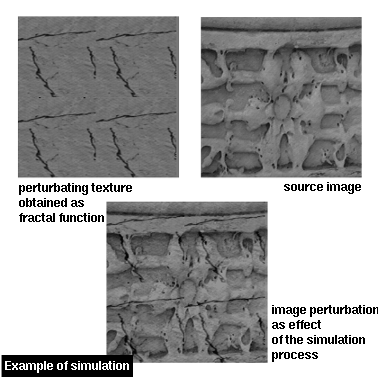
Example of simulation: upper left - perturbating texture, obtained as fractal function; upper right - source image; lower image - image perturbation as effect of the simulation process.

by Laura Moltedo and Ovidio Salvetti
The concept of texture can be studied in image analysis and synthesis with the aim of identifying a set of criteria for unification. Texture can be defined as a characteristic parameter of an image, and a particular significance can be assigned to it for the recognition of objects (analysis) or the definition of features for the visualization of scenes (synthesis).
In general, texture can be considered as a discriminating element among objects characterizing the same real or generated scene. This could be very helpful in the definition of classes of simulators used to study phenomena or events subject to perturbation, and described or codified in pictorial form. Such simulators should be based on a general model which can integrate two stages: interpretation of an image on the basis of its texture features; generation of an image from any kind of description.
Texture can generally be characterized in two modes: numerically or syntactically. The first mode includes three categories of algorithms differentiated by the type of decomposition performed, or by the type of feature extracted from the image: spectral decomposition; decomposition based on statistical functions; other types of decomposition. The second mode uses data structures such as trees and graphs, in which the different features which define the texture are expressed by grammars of varying degrees of complexity, and the different texture descriptors are associated with nodes.
Two complementary approaches have been considered. Each approach studies appropriate mathemetical models which can be considered as the base elements of a simulator. The first one employs geometric properties, the second fractal theory. Both approaches are based on procedures in which a set of "texture descriptors", derived by analysing sample images, are used as input so that the original graphic and pictorial properties can be reconstructed.
A number of different methods have been developed and applied to a single reference image (a chessboard), and to different real images (of marble and stone), to test their performance and robustness. In this way, we have been able to compare the two models to identify their main features. The integrated environment implemented was then applied to real world cases in the art conservation sector.
A texture-based simulator implementing a preliminary unification model has been designed.This can be considered as a prototype version for a general model which will evaluate the behaviour of material subjected to conditions of downgrading or depreciation. Samples were examined (image analysis), and the variations which corresponded to different perturbing agents were studied (image synthesis). In particular, it was possible to acquire images extracting those features of their texture which make it possible to discriminate between homogeneous zones; then the parameters computed were inserted in geometric or fractal functional descriptors which can be used to reconstruct the original images. In this way, an image can be considered as a parameter of a model which is mathematically "extendible" with appropriate perturbing functions.
The algorithms have been written in C, and the PHIGARO libraries and PHIGS standard have been used on a UNIX platform for the visualization. The PHIGS environment was chosen in order to facilitate transfer of the modules to other machines. In addition, as it is a 3D extension of X, the software can be transferred to the PEX environment, and the programs can be written both under PHIGS and X-windows. The images were acquired using a high resolution CCD camera.

Example of simulation: upper left - perturbating texture, obtained as fractal function; upper right - source image; lower image - image perturbation as effect of the simulation process.